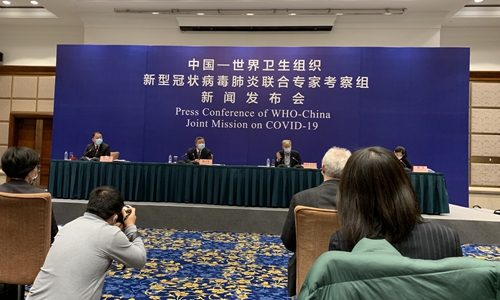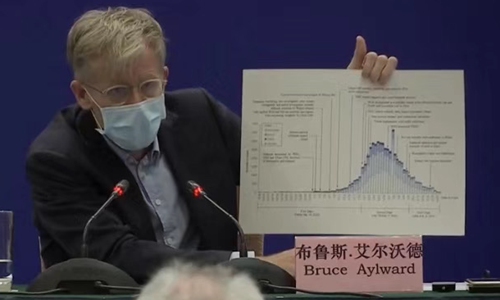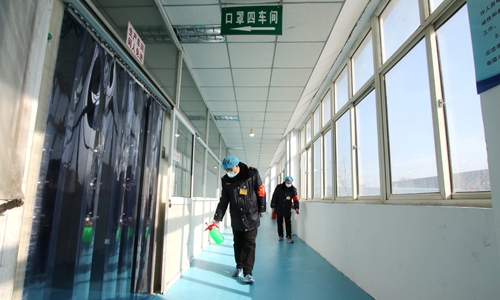HOME >> CHINA
'China's experience needed’
By Chen Qingqing Source:Global Times Published: 2020/2/24 20:58:55 Last Updated: 2020/2/25 0:09:10

The World Health Organization (WHO)-China Joint Mission on COVID-19 gives a technical briefing in Beijing on Monday. Photo: Chen Qingqing/GT
The organization also urged other countries and regions to learn from China's lessons, the most important of which is the speed of the action.
"The world needs the experience and expertise of China, as the country is the most experienced in the world, which has turned around a serious outbreak," Canadian epidemiologist Bruce Aylward, who heads the WHO mission team to China, said on Monday at a technical briefing upon the completion of the WHO-China Joint Mission on COVID-19, adding that the only success the world had in tackling COVID-19 is in China, where old approaches like suspension of travel and quarantine were used.
"There's no question that China's bold approach has changed the course of the rapid escalation of this epidemic. These significant measures could only be adopted with tremendous collective will, not only in the community but also [among] top officials, which is also rare to see," Aylward said.
Before he addressed the media, Aylward sent out condolences, in a highly emotional way, to all the Chinese people who lost their lives and their family members amid the outbreak while expressing a special gratitude to people in Wuhan, capital of Central China's Hubei Province, where the COVID-19 originated, as they have made great contributions to the epidemic control work.
Citing several examples he noticed during this trip to China, the Canadian epidemiologist said he was impressed by the capacity of social mobilization and tremendous collective will of top-down officials and Chinese people in containing the virus, but without proven pharmaceutical measures yet, the disease can be extremely dangerous.
He described those measures such as keeping a social distance, implementing quarantine and city lockdowns as old-fashioned but aggressive as well as ambitious, underscoring a huge sacrifice that Chinese people have made for the happiness of others – not only in China but also in other countries.
"We have to work with what we have. China's approaches are the only ones that we know work," he said.
One example, as Aylward mentioned, was although every province suffered from the epidemic, local governors always prioritized mobilization of medical workers and supplies to support Wuhan and Hubei.
He noted that the ongoing slowing spread by weeks thanks to China's efforts can "buy time to test drugs, work on vaccines," and the international community needs to use the time China has bought to better effect.
China's National Health Commission (NHC) reported 409 new coronavirus infections nationwide, 150 new deaths as of Monday. The total number of infected soared to 77,150, with 2,592 deaths as of Monday.
Outside China, there were 1,769 confirmed cases as of Monday and the death toll reached 17. The disease has spread to 28 countries and regions across Asia, Europe, and the Middle East, with South Korea, Japan and Italy recording spikes in recent days.
The decline is real, Aylward noted, referring to visible progress that China has made in epidemic control work as the daily new infections have been dropping in recent weeks.
The number of coronavirus cases reported in China a day has dropped from 2,500 when he arrived two weeks ago to 406 on Monday, he noted. "That's an 80 percent decline and the decline that we are seeing is real," the expert said.
It has been a month since Wuhan - a city with 11 million people - implemented the city lockdown, while other provinces, municipalities and autonomous regions implemented various measures to control population flow in containing the epidemic at the cost of social and economic growth.
When asked about whether the epidemic in Wuhan is getting close to an inflection point, the WHO expert said as cured numbers rose and new infections continued to drop, it showed a rapid escalation of the outbreak has been contained. However, when daily new infections drop to double digits in the next few weeks, it would be the time to decide whether the epidemic is under control.
Italy is taking similar moves. The WHO official said he has explained to the world that there are benefits from extreme containment measures, which are the tools available to fight the disease.

A screenshot of Monday's press conference
Findings and suggestionsThe mission's report has 22 recommendations for other countries and China itself, including recommendations for the general public, which, however, can't work without the collective will of the population contributing to it.
This virus is neither SARS nor influenza and viewing it as one or the other impedes the ability to learn about the virus and adapt the response, the WHO official noted.
According to the major findings of the WHO-China Joint Mission, the deadly coronavirus has not significantly mutated.
"The animal host has not been confirmed - a bat could be the host, but also a pangolin," Liang Wannian, head of the Chinese expert group at the joint mission, who is also in charge of responding to COVID-19 at the NHC, said at the press briefing.
The joint expert team visited Wuhan over the weekend after completing investigations in Beijing, South China's Guangdong Province and Southwest China's Sichuan Province.
The mission aims to learn more about the epidemic features, including the source of transmission, to better understand the Chinese government's policies and the future response to the epidemic, and to put forward recommendations for relevant scientific research, Liang said.
"The transmission route is respiratory droplets. The fecal-oral route needs to be further studied," Liang said.
About 80 percent are milder cases and about 13 percent are severe, while 6 percent are critically ill, the WHO-China joint mission technical report showed. About 1 to 5 percent of the close contacts to coronavirus patients were later confirmed to be positive.
Liang said that 3,000 medical staff are estimated to have been infected nationwide and scientists are studying which cases were infections in hospitals and which were in communities.

Volunteers who are also members of the Communist Party of China spray disinfectant on mask production companies on Monday in an industrial park in Handan, North China's Hebei Province, to help local companies resume work while preventing the virus spreading amid the outbreak. Photo: cnsphoto
A large part of medical staff infections took place in Wuhan, which is mainly due to the initial lack of understanding on COVID-19 and the lack of protective supplies, he said.Epidemiological curves showed China's measures have helped avoid a larger scale of outbreak that could have involved more than 100,000 people. Those changes didn't come easy, due to huge decisions of policymakers, like suspending travel and other quarantine measures, Aylward said.
He noted that there's only one drug right now - Remdesivir - that might be effective. But enrollment in a clinical trial has been slow because other things are being tested, according to the briefing.
Aylward also shared the changes he saw in Wuhan, such as the growing space in Wuhan hospitals in treating patients.
While the virus may continue to spread in China for months, it's time for the country to restore economic and social order while continuing epidemic control. In some major cities, restrictions should be lifted progressively, the WHO expert suggested.
Posted in: SOCIETY